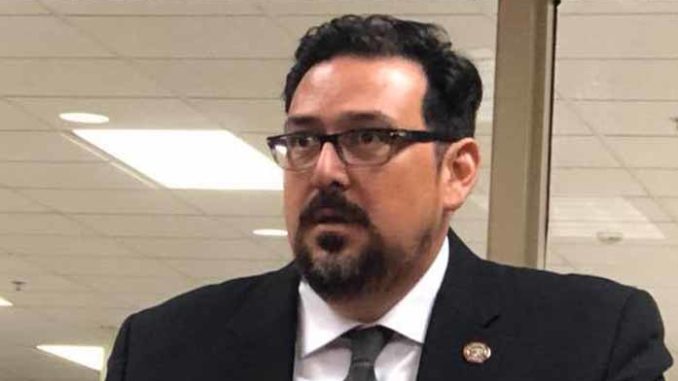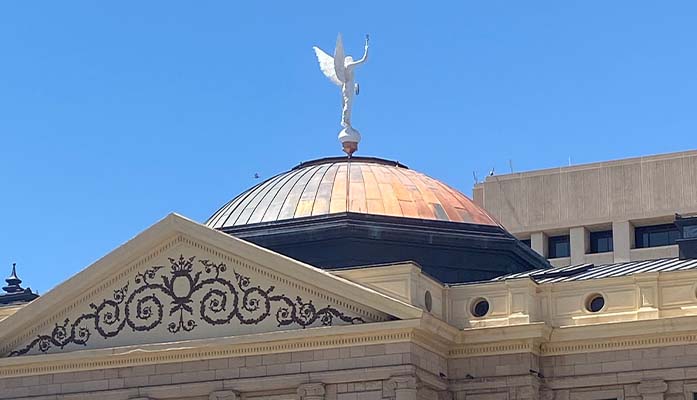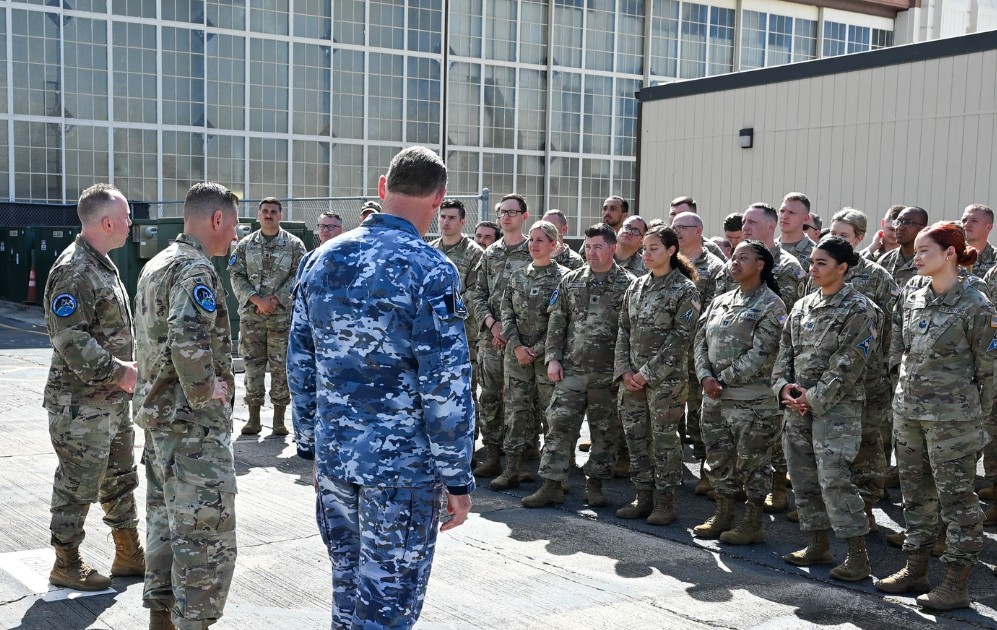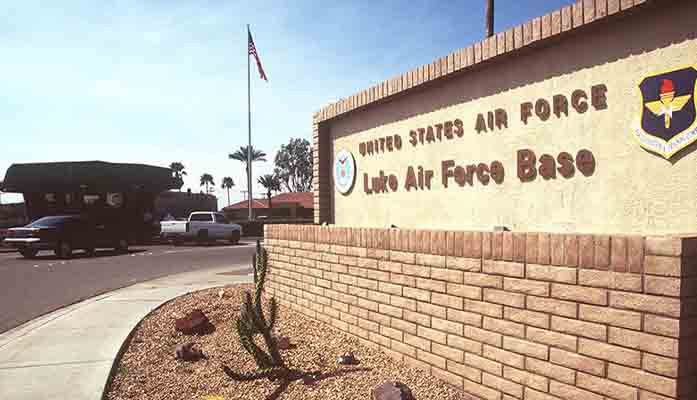
by Jonathan Eberle | Jul 23, 2025 | News
By Jonathan Eberle |
In a tense and disorganized special meeting last week, the Arizona Democratic Party voted to remove Chair Robert Branscomb after just six months in office. The ouster followed months of infighting, public disputes with elected officials, union clashes, and growing concerns over the party’s financial health heading into the 2026 election cycle.
Branscomb, who was elected chair in January after unseating incumbent Yolanda Bejarano, faced mounting criticism from party leaders and lawmakers. Arizona’s top Democratic elected officials—including U.S. Senators Mark Kelly and Ruben Gallego, Governor Katie Hobbs, Attorney General Kris Mayes, and Secretary of State Adrian Fontes—issued a rare public rebuke earlier this year, expressing a loss of confidence in his leadership.
Despite technical problems that plagued the meeting, 476 party committee members voted to remove Branscomb through the party’s preferred voting method, surpassing the two-thirds threshold required by Arizona Democratic Party (ADP) bylaws. Some members cast votes by email due to glitches in the party’s online voting system, though the total vote count remains unclear.
“Today’s recall effort is rooted in misrepresentation, divisive tactics and does not reflect our democratic values,” Branscomb said during the meeting. He argued that his removal was not about party unity but about “distraction and dividing us at a time when unity is more important than ever.”
Several lawmakers and party officials cited concerns over Branscomb’s ability to lead Democrats to victory in the next election. “Donors have told me directly they’re sitting out until the party gets its act together,” said State Representative Aaron Márquez.
The July 16 meeting stretched on for hours as frustrations mounted over procedural confusion and technical failures. Several members said they did not receive links to vote on the quorum, raising fears that they would be disenfranchised. Over two and a half hours were spent troubleshooting the party’s online voting platform.
Much of the confusion appeared to stem from tensions between party officers and ADP Executive Director Michael Ruff, who was tasked with managing the voting system. Some staff members claimed in Zoom chat messages that they had offered to help with the process but received no response.
ADP Vice Chair Melissa Galarza criticized the disorganization, saying, “I just feel like this was not well planned, the staff was not prepared for it, Michael Ruff did not prepare us, we had a lack of conversation about this meeting.”
A new election to select the party’s next chair is scheduled for September. Branscomb has the option to challenge his removal in that meeting. Until then, ADP Vice Chair Kim Khoury will serve as interim chair.
Jonathan Eberle is a reporter for AZ Free News. You can send him news tips using this link.

by Matthew Holloway | Jul 23, 2025 | News
By Matthew Holloway |
Arizona Representative Nick Kupper (R-LD25) has stepped up to the ongoing controversy surrounding the hacking of the Arizona Secretary of State’s website. The lawmaker has requested a formal briefing from Secretary of State Adrian Fontes to account for the attempted breach of security to all members in the legislature, not merely the “select members” already discussing the matter.
The incident was reportedly carried out by Iranian hackers, according to the Secretary of State’s Office, who replaced images of the candidates on the website with images of the late Ayatollah Ruhollah Khomeini.
In a letter to Fontes, Kupper wrote in part: “While I understand your office has communicated with select members of the Legislature regarding this issue, I believe that all lawmakers should be afforded the opportunity to receive a comprehensive briefing on the nature of the attempted breach, any data or system vulnerabilities identified, and the steps you have taken to ensure the integrity and security of our electoral infrastructure.”
Kupper referenced reported failures in the AZSOS candidate portal noted by Turning Point Action’s Tyler Bowyer last week, writing, “Since the incident, the candidate portal has experienced noticeable slowdowns, which have affected accessibility and overall functionality.”
In a statement released alongside the letter to Fontes, Kupper noted, “Arizona’s election systems should never be this easy a target for foreign adversaries. This wasn’t a prank — it was a politically motivated act of cyberwarfare, and we deserve answers. Every legislator has a responsibility to understand what happened and what’s being done to keep it from happening again.”
Kupper has called for “a comprehensive briefing on the breach, including how it occurred, what systems or data may have been accessed, and what steps are being taken to prevent future incidents.”
The Arizona Representative even offered to arrange the logistics of “a full in-person briefing that will be open to all Arizona House Members and State Senators,” with the reservation of a conference room in the Arizona House of Representatives. He added that the briefing should occur in the next two weeks.
Reporting from KJZZ revealed that the images uploaded by the hackers were also linked to social media accounts, including a Telegram account which wrote, “We were not looking for war or adventure. However, President Trump’s flagrant violation of the agreement, through his aggressive attack on the nuclear and civilian infrastructure of the great nation of Iran, has forced us to face a difficult and regrettable confrontation. Now the American people share in the consequences of his risky decision. Our erosion revenge has begun.”
The attacks persisted for approximately a week, according to Arizona Department of Homeland Security Spokesman Aaron Thacker: “What this incident has done is it’s created — it’s not just an attack on the Secretary of State’s Office. It’s also an attack on government as a whole. We are not the only agencies that are being attacked.”
Thacker added, “When it comes to our overall collective security, this isn’t really something we should be playing politics with, and there have been a few folks that are being unnecessarily critical.”
Matthew Holloway is a senior reporter for AZ Free News. Follow him on X for his latest stories, or email tips to Matthew@azfreenews.com.

by Matthew Holloway | Jul 23, 2025 | News
By Matthew Holloway |
Congressman Paul Gosar (R-AZ09) joined a growing bipartisan chorus calling for an investigation into the Dragon Bravo Wildfire.
Gosar’s statement differed slightly, however, from Democrat leaders in one key concern: the culpability of the Biden administration.
Raging across the North Rim of the Grand Canyon National Park, the wildfire escalated quickly, destroying the historic Grand Canyon Lodge as well as park administrative offices and residences. As of this report, the massive blaze is currently 8% contained and has burned over 12,000 acres. Approximately 70 buildings have been destroyed.
According to the Grand Canyon National Park Service, the fire was started by a lightning strike on July 4th and was allowed to burn for a few days for “resource objectives.” It was behaving as planned until “really strong aggressive winds” arose from the canyon and “changed the fire behavior dramatically very quickly,“ National Park Service Public Affairs Officer Joëlle Baird told AZ Family.
Robert Rickey, a National Weather Service science operations officer in Flagstaff, told the outlet that a mixture of high-pressure, disappearing humidity, and high winds triggered the explosive expansion of the fire.
“We had this big area of high pressure. All that moisture basically evaporated,” he said. “In terms of humidity, we consider 15% to be a critical threshold, so when we’re seeing humidities in the single digits, I mean that’s about as low as it can possibly get.”
Wind gusts at Grand Canyon National Park reportedly hit as high as 40 mph.
“The winds shifted more toward the northwest, and I think that really caused them some issues,” Rickey said per AZ Family. “When you get more of a northerly flow at night time, all that air just drops right down into the Grand Canyon and so basically it accelerates right along the rim.”
In a single day, the fire exploded from 120 acres to 1,500 acres.
Ken Phillips, a 27-year veteran employee at the Grand Canyon and former chief of emergency services told The Guardian that he believes the decision to “control and contain” the fire initially was a mistake.
“The North Rim did not need to burn the way it did and put firefighters in harm’s way,” he said. “There is a history of escaped managed wildfires at Grand Canyon. It is very tragic that the lessons learned from those fires weren’t heeded in this situation.”
Rachel Pawlitz, a National Park Service (NPS) spokeswoman, offered a different view in an interview with the Arizona Republic. She defended the park’s response saying, “The National Park Service and our interagency partners actively fought the Dragon Bravo fire employing tactics that met the suppression objectives and mitigated risk. Firefighters had constructed containment lines and were prepared to conduct a defensive firing operation before conditions rapidly changed.”
NPS told the outlet that the fire was “expertly handled.”
In a statement to the Republic, Gosar’s spokesman, Anthony Foti, said, “The Congressman is both sickened and troubled by the fire. As the dean of the Arizona congressional delegation and as member of both the House Oversight and Government Reform Committee and the House Natural Resources Committee he will be calling for a full and complete investigation. More details very soon.”
Congressman Gosar said in a statement, “I am concerned that the Dragon Bravo Wildfire is the direct result of recently inherited policies from the Biden Administration.”
“We must not waver in our efforts to seek answers for the people of Arizona. Today, I call on Secretary of the Interior, Secretary Burgum, to seek answers for the people of Arizona, who want answers as to the causes of this disaster and what can be done to prevent tragedies like this in the future.
“The people of Arizona will not be calling for answers alone. I will continue to seek answers and solutions, because these wildfires deeply impact Arizonans and our state.”
In a letter to Secretary of the Interior Doug Burgum, Gosar wrote, “I am concerned that the spread of the Dragon Bravo Wildfire is the direct result of the recently inherited policies from the previous administration. Specifically, the Biden-Harris administration promoted policies that allowed for the mass overgrowth of brush, prohibited effective fuel reduction operations, and locked up the lands from resource development.”
He added, “President Trump’s Executive Order 14308, published on June 12, 2025, sought to correct this mismanagement and empower the Department of the Interior (DOI) to identify the steps necessary for innovative wildfire response—with some actions already identified by Congress, like forest thinning and improved suppression response times.”
Matthew Holloway is a senior reporter for AZ Free News. Follow him on X for his latest stories, or email tips to Matthew@azfreenews.com.

by Ethan Faverino | Jul 22, 2025 | News
By Ethan Faverino |
The Arizona Republican Assembly (AZRA) has released its Final Legislative Scorecard for the 2025 Arizona State Legislative Session.
This scorecard evaluates Arizona State Senate and House of Representatives members based on their voting records and alignment with AZRA’s core principles of limited government, individual liberties, and fiscal responsibility.
As primary elections approach, this scorecard is a critical tool for voters to distinguish authentic conservatives from those who merely claim the label.
The AZRA Legislative Scorecard is the only one, not only in Arizona but in the nation, where a committee of twelve members from across the state invest thousands of hours analyzing over 1,800 bills annually, rating more than 250 bills.
AZRA then publishes these bill ratings before legislative votes, notifying every legislator in advance and inviting feedback to ensure fairness. To maintain integrity, AZRA contracts a national data firm that receives daily voting data from the Arizona Legislative Council, updating results without manipulation or bias.
The scorecard lists 30 State Senators and 60 State Representatives, providing numerical scores out of 100 based on weighted votes on key bills. Scores are presented alphabetically by last name for letter grades, in descending order, along with party affiliation and legislative district.
Among senators, Senate President Warren Petersen (R-LD14) earned the highest score of 98.5, followed by Senator Wendy Rogers (R-LD7) at 96.9, Senator David Farnsworth (R-LD10) at 95.9, and Senator Timothy Dunn (R-LD25) at 95.5.
The highest-ranking Democrats were Senator Brian Fernandez (D-LD23) at 40.5 and Rosanna Gabaldón (D-LD21), at 34.1. The lowest scoring Democrats were Lauren Kuby (D-LD8) at 25.4 and Priya Sundareshan (D-LD18) at 23.8.
Representative Selina Bliss (R-LD1) led the House with a score of 96.8, followed by a four-way tie at 96.1 among Majority Leader Michael Carbone (R-KD25), John Gillette (R-LD30), Quang Nguyen (R-LD1), and James Taylor (R-LD29).
Rep. Bliss recognized AZRA’s Scorecard saying, “It is an honor to be recognized, along with seatmate Quang Nguyen, by the Arizona Republican Assembly for our work at the Capitol!”
Out of the Democrat Representatives, Alma Hernandez (D-LD20) scored the highest with a 49.4 and Consuelo Hernandez (D-LD21) with a 48.8. The lowest ranked Democrats are Quantá Crews (D-LD26) with a score of 26.6 and Mariana Sandoval (D-LD23) with a 25.5.
The AZRA scorecard reveals a significant divide in voting patterns between Republican and Democratic legislators in the Arizona State Senate and House, with Republicans ranging from 78.7 to 98.5 and Democrats scoring from 23.8 to 49.4.
Correction: This story originally stated that there are 50 State Representatives. The story has been updated to reflect the correct number at 60 State Representatives.
Ethan Faverino is a reporter for AZ Free News. You can send him news tips using this link.

by Ethan Faverino | Jul 22, 2025 | News
By Ethan Faverino |
Congressman Juan Ciscomani (AZ-06) announced his support for Fort Huachuca as a leading candidate for a new U.S. Space Force mission, as the U.S. Department of the Air Force evaluates four potential sites nationwide.
On July 8, 2025, Air Force leadership briefed Congressman Ciscomani’s office on the proposed site selection process, which aims to establish a cutting-edge Space Force mission system to enhance space awareness capabilities for Combatant Commands.
Fort Huachuca, located in Arizona’s 6th Congressional District, emerged as a top contender due to its unique strategic advantages.
“Southern Arizona is the Astronomy Capital of America for a reason, with stark advantages for air and space operations that include beneficial geographic qualities as well as outstanding community investment,” said Congressman Ciscomani. “Specifically, Fort Huachuca’s unmatched airspace and technical capabilities position it as an outstanding location to support Air and Space Force innovation. While this is an ongoing process, I am proud to support our district to fullest.”
The proposed mission aligns with Sierra Vista’s growing importance in the aerospace sector. Dr. Randy Groth, President of Fort Huachuca 50, emphasized the regional impact by saying, “The possible selection of Fort Huachuca as the principle location for this new USSF mission and squadron could place Sierra Vista and the surrounding community in a lead position for the space economy. We stand ready to support the Air and Space Forces and Fort Huachuca to make this potential mission a success for our region and nation.”
Fort Huachuca, along with Davis-Monthan Air Force Base, anchors Arizona’s 6th District as a hub for critical military operations, supporting national security and the 80,000 veterans residing in the district.
Congressman Ciscomani remains committed to collaborating with the Department of Defense and Air Force leadership to secure Fort Huachuca’s selection, reinforcing Southern Arizona’s pivotal role in 21st- century military innovation.
Ethan Faverino is a reporter for AZ Free News. You can send him news tips using this link.

by Ethan Faverino | Jul 21, 2025 | News
By Ethan Faverino |
Congressman Abraham Hamadeh (AZ-08), a member of the House Armed Services Committee, has delivered a landmark victory for Arizona’s military community, bases, and defense industry through the passage of the 2026 National Defense Authorization Act (NDAA).
During an intense 13-hour amendment process, Congressman Hamadeh delivered over 30 bipartisan provisions, securing critical investments and reforms for Arizona’s servicemembers, veterans, and defense sector.
“I am grateful to my fellow Arizonans and members of the Arizona Congressional Delegation for their input and support of these monumental achievements for our state. They range from investing in cutting edge technology for our warfighters, to preserving our rich military history, to making sure service members are not financially burdened when they want to bring family pets home from abroad,” said Congressman Hamadeh. “My constituents and American voices are being heard on the issues that these amendments address to make sure that we are spending the taxpayers’ money carefully and in a way that addresses the critical national defense and quality of life issues of today and tomorrow.”
Key wins for Arizona’s 8th District include:
- Suicide Prevention Oversight: mandates a Department of Defense report on suicide prevention resources under The Brandon Act, honoring AZ-08 servicemember Brandon Caserta, who was sadly, a victim of suicide. Co-led with Senator Mark Kelly (D-AZ).
- Protecting Luke Airforce Base Leadership: This requires a report on the operational and cost impacts of downgrading leadership at Luke Airforce Base.
- Next-Generation Body Armor: Directs a report on innovative body armor development by Peoria based company, TYR Tactical, to counter advanced threats form adversaries like China and Russia.
- Improving Industry Regulations: Eliminates burdensome red tape for machine gun testing, benefiting AZ-08’s savings and national defense industry. Co-led with Rep. Ron Davis (D-NC).
- U.S.–Mexico Airspace Cooperation: Explores unprecedented collaboration with Mexico to enhance training capabilities at Luke Airforce Base, MCAS Yuma, and Ft. Huachuca while addressing border drone threats.
- Reliable Air Conditioning at Luke Airforce Base: Addresses critical HVAC failures to improve conditions for servicemembers, especially during the hot summers of Arizona.
- Submarine Air Recycling Innovation: Supports AZ-08 innovators developing cleaner, more reliable air recycling systems for submarines.
- Advanced Satellite Technology: Promotes AZ-08’s production of cutting-edge gyroscopes to enhance intelligence, surveillance, and reconnaissance capabilities.
Statewide Impact for Arizona:
- Protecting Ft. Huachuca’s Electronic Proving Ground: Prevents 44% staff cuts with a required review before reductions are finalized. Co-led with Senator Mark Kelly (D-AZ).
- Saving Mesa’s Apache Helicopter Jobs: Secures orders for three additional AH-64D to AH-64E conversions, preserving jobs. Co-led by with Reps. Andy Biggs (R-AZ) and Greg Stanton (D-AZ).
- Preserving Aviation History: Frees five T-37 jets from Tucson’s boneyard for restoration by the Arizona Aviation Historical Group to promote STEM and recruitment. Co-led with Senator Mark Kelly (D-AZ).
- Western Training Range Complex: Directs the Department of Defense to link Arizona bases for joining warfare simulations. Co-led with Senator Mark Kelly (D-AZ).
- Securing Ft. Huachuca’s Water Access: Ensures water availability for the base and surrounding communities against environmental lawfare.
- Improving Safety at Barry M. Goldwater Range: Distributes $1.1 million for network coverage to prevent accidents and curb smuggling.
- Commending Davis-Monthan’s New Special Operations Wing: Reinforces Congressional support for the new Air Force Special Operations Wing.
- Advancing Autonomous Robotics: Recognizes Arizona’s leadership in developing swarm-capable autonomous ground vehicles.
- Strengthening Psychological Operations and Civil Affairs: Requires a briefing on integrating units like Buckeye’s 492nd Civil Affairs Battalion into Army initiatives.
- Expanding Air National Guard Refueling Fleet: Raises the floor for refueling tankers, supporting Phoenix’s 161st Air Refueling Wing.
- Countering Cross-Border Tunnel Threats: Extends partnerships with Israel to address Arizona’s emerging tunnel threats.
- Standard Missile-6 Production: Supports Tucson’s missile production with a report and investment to reduce bottlenecks.
- Collaborative Combat Aircraft Propulsion: Fast-tracks jet engine production in Phoenix for autonomous aircraft.
- Increased Dump Truck Investment: Boosts acquisition of safer, reliable dump trucks for Arizona’s Army National Guard.
- Directed Energy Weapon Development: Sends demand signals for counter-drone directed energy weapons developed in Arizona.
- Regenerative Space-Based Solar Production: Requires a briefing on space solar manufacturing, where Tempe is the center of technology innovation.
- Irregular Warfare Consortium: Commends Arizona State University’s Department of Defense Irregular Warfare Center and requires a briefing on its long-term strategy.
- Addressing Missile Inventory Shortfalls: Applauds the Enterprise Test Vehicle program and directs a briefing on innovative air vehicle production processes.
National Security Advancements:
- Pets Are Family: Extends Fly America Act exemptions to allow Department of Defense personnel to travel with up to three pets on foreign airlines, aligning with State Department policies and supporting military families’ quality of life.
- Security Clearance Reform: Requires a report to address delays, improve transparency, and ensure a robust pipeline of cleared personnel to meet future defense needs.
- Global Threat Response: Authorizes a one-year extension of the counter-ISIS train and equip program in Iraq and Syria, reducing U.S. boots on the ground while preventing the resurgence of the Islamic State.
- High-Altitude Balloons and Platforms: Requires a report from the Secretary of Defense on current efforts and future potential of high-altitude platforms, ensuring the U.S. maintains a competitive edge in advanced surveillance capabilities.
- U.S. Leadership in Space-Based LiDAR: Directs the Air Force and Space Force to provide a briefing on strategies to sustain U.S. dominance in space-based LiDAR for high-resolution observation, targeting, and object identification, countering China’s advancements.
- Oversight on Military “Titling” Practices: Requires a review of unjust “titling” practices, recommendations to protect servicemember privacy from adverse consequences, and exploration of expungement and redress mechanisms. Coordinated with Rep. Eli Crane (R-AZ) and Rep. Cory Mills (R-FL).
Congressman Hamadeh’s unanimously passed amendments reflect collaboration with Arizona’s congressional delegation. He looks forward to partnering with Senate colleagues to deliver these provisions to President Donald Trump’s desk, advancing Peace Through Strength.
Ethan Faverino is a reporter for AZ Free News. You can send him news tips using this link.






